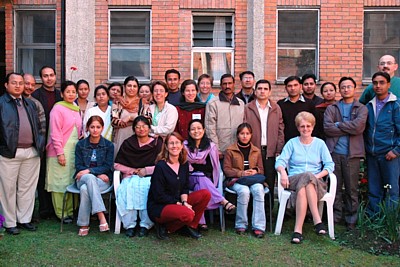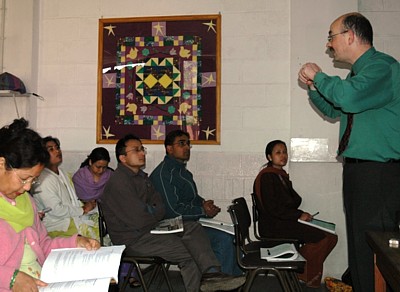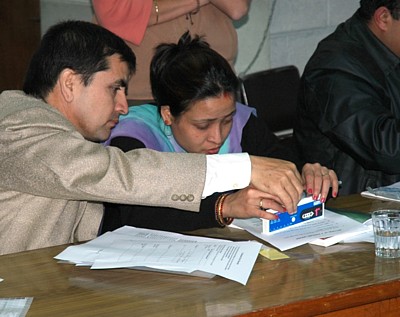Regional Reports
From the Czech Republic
Presentation of the outputs of the “Palliative Care in the Czech republic ” project (2003-2004) in the Parliament of the Czech Republic - February the 15th 2005.
Project Palliative Care in the Czech Republic (CR) seeks to radically improve the care provided to the incurable, dying and their families in the Czech Republic. It aims to improve the knowledge of both professional and lay public about modern palliative care and to promote principles of quality care for the dying throughout the whole health and social care system.
Cesta domu (The Homecoming), a hospice unincorporated association , was a bearer of the Project. The Association focuses on two complementary areas of activities:
- It has founded and operates a home hospice in Prague , where specific support is provided to families who decided to care for their dying relatives at home;
- It endeavours, after social and legislative structural changes, to enable the Czech Republic to extend quality care to the dying.
The Project was funded from the Public Health programme introduced by the Open Society Fund, Prague.
In May 2004 a report about the state of Palliative care in CR was presented in Parliament:
Dying and Palliative Care in CR (situation, reflections, prospects)
Research report and critical issues for the development of palliative care in the Czech Republic
The report includes an analysis of epidemiological data on dying, a public opinion research, an opinion poll performed in selected groups of inhabitants, a “focus group” research among health care professionals, education programmes mapping, a questionnaire survey of current providers of palliative bed care in the Czech republic, a description of a mobile hospice pilot project and, based on data collected, it defines areas decisive for further improvement of palliative care in the Czech Republic.
The first major research in the Czech Republic focused on the care for terminally ill and dying, in years 2003-2004, and was one of the issues of this report. The following results were obtained and presented:
- The public is unhappy with current state of care for dying. Even the best evaluated area of care (treatment of pain) was judged as “good” by only 7% of respondents, and “as rather good” by 29%
- Alarming is the discrepancy between preferences of the public and real status of care provided for terminally ill and dying in our country: approximately 75% of all deaths occur in health care or social care facilities (hospitals, nursing homes, retirement homes), yet 80% of those, who responded to this question, would not want to die in these institutions.
- The group of students evaluated current care for dying even more critically than the public. It is therefore not surprising, that 91% of them evaluate the improvement in care for dying as important.
- The most critical in their evaluation of the care for dying are those, who have most experience with it, which are health care providers and social workers. And especially those, who provide care for dying most frequently (oncologists, workers of nursing homes, retirement homes and hospices).
- Large numbers of dying suffer from inadequately controlled pain and other physical symptoms, though modern medicine can effectively treat most such problems.
- The area of care for terminally ill and dying viewed most critically by both lay and professional public is the lack of attention paid to psychological suffering of patients and the lack of attention given to their family and friends.
- 90% of interviewed young physicians feel that they are not trained to communicate with the terminally ill and their families.
- Specialized, modern palliative care in hospices is available to only 1% of all terminally ill and dying.
- Continuity and coordination of care for dying is frequently poor. In the last weeks of their life, patients are frequently being transferred between various health care facilities.
- Participation by patient and family in important decision -making about treatment is rather an exception. Communication between physicians and patients regarding diagnosis and prognosis varies and generally is inadequate.
- The family of a terminally ill patient who decides to care for their patient at home undergoes a risk of an extremely demanding process without the security of any financial support, and, at times, against opposition from their physician.
- No institution in Czech Republic currently monitors quality of care for dying. Criteria for this care have not been developed.
The research proved that there is a pressing need to:
- Improve quality of care for dying
- Radically increase access to modern palliative care
- Develop home-based palliative care
- Profoundly improve the care for dying in health care and social institutions, most of all in nursing homes and retirement homes
A review of areas where the need for change seems most pressing was presented:
- Education of health care providers and other caring professionals.
- Influencing professionals, primary through their medical societies,
- Support of local innovative projects.
- Follow-up and evaluation of care for terminally ill and dying.
- Development of home-based palliative care
- Utilization of proven methods from abroad
- Ongoing popularization of the theme of care for dying
As concrete contributions toward the realisation of changes occuring in the systém to provide care to dying in CR, Cesta domu has organized a second presentation in Parliament in February 2005. Also, 5 publications were presented to, and discussed with, the health care providers, politicians and to the public. They were edited by Cesta domu as an answer to the main problems and barriers of the Palliative care environment in the Czech Republic.
Presented were these publications as outputs of the project:
- On Organisation of Palliative Care - An essential document of European significance emphasizing palliative care as an enormously important part of the system of health care services.
- Palliative Care Policy in the Czech Republic - A draft of palliative care policy in the Czech Republic is based on the hitherto experience with delivering palliative care both abroad and in the Czech Republic.
- Education in Palliative Care - A draft of training programmes designed for university and graduate education of physicians.
- Home Palliative Care Standards - A draft of basic standards applicable to special palliative home care.
- Respect for Human Dignity - A guide for professional training, education and training of students in medical, health care and health and social care schools and universities.
All these publications are now of great interest to health care providers, both professional and non-professional. The draft of the Concept of Palliative Care in the Czech Republic is now used as a working document by the Ministry of Health Committee for Palliative care. Based on this project, in April, 2005, Cesta domu has prepared a new website www.umirani.cz (umirani = dying) for wide use by the public.
We hope the presentation in Parliament in February will bring about the most important changes in End of Life Care in CR. Much has been done by volunteers, nurses, civic initiatives and hospice-care providers, but now we expect an important step forward by government and other institutions.
Martina Spinkova, Cesta domu, Prague
1. 5. 2005
From Nepal
A Palliative Care Initiative in Nepal
By Dr. Max Watson ( UK )
The Princess Alice Certificate in Essential Palliative Care (International) was completed in Kathmandu on February 27 2005 .
This eight week home study course involving a five module handbook, with associated video programmes, and a case based portfolio has been run in the United Kingdom at Esher and at Belfast since 2001. During this time, over 500 candidates have enrolled in the programme.
Together with Partnership in International Medical Education (PRIME), the course was established in Nepal in an attempt to meet a growing need for palliative care education.
Jenika Graze, a specialist palliative care nurse from Australia currently working in Nepal , who was responsible for co-ordinating the course, explained that,
“We hoped that by providing a recognised qualification that was focused on practical palliative care, we could start to address some of the palliative educational needs that are arising across the country.”
In total, some 27 candidates completed the course in Kathmandu . These included 17 doctors and 10 nurses from 10 different hospitals across the country.
The eagerness of these candidates to learn was emphasised when many chose to fly into Kathmandu to bypass the Maoist siege of the city and the disruption caused by the recent power takeover by King Gyendra.
Specialist nurse Lynne Kovan and palliative care consultant Dr Max Watson travelled from the UK to conduct a final three days of revision lectures and the course assessment at Patan hospital in the Kathmandu valley. During the three day revision programme there was also an opportunity for valuable net-working and sharing of ideas from different palliative care professionals working in a wide range of Nepali settings.
Despite the teaching being carried out mostly in English, which, for many of the candidates was a third or even fourth language, the quality of work completed by the Nepali doctors and nurses compared very favourably with that of students back in the UK.
The course also allowed for practical teaching in the use of syringe drivers, which until now have not been readily used in Nepal . Through the generous donations of various bodies, some 30 syringe drivers were left under the care of Hospice Nepal who has taken on the responsibility for training other centres in syringe driver use, distribution and monitoring.
Dr Rajesh Gongol, a consultant general surgeon and one of the co-founders of Hospice Nepal , spoke very enthusiastically about the course.
“The certificate programme has more than matched our expectations and through the use of lots of Nepali pictures and illustrations has been made very relevant to our practical palliative care needs. We hope that the course will be run on a regular basis to help meet the huge palliative care needs of the country”
Learning to “Drive” in Nepal
By Jenika Graze
With bated breath and unsteady hands the needle is inserted. Patients and relatives crane to see. We listen for the whirring sound. Nepal ’s first syringe driver starts doing its work. 24 hours later Ramesh’s pain is under control. Five days later he is back in his hillside village home, surrounded by his family.
What a responsibility! Thirty syringe drivers neatly stacked on the bookshelf in my study, waiting for the right time to be introduced into various institutions around Nepal . These, the first ever syringe drivers in Nepal, were brought to Kathmandu in February 2005 by Dr Max Watson and Practice Facilitator Nurse Lynne Kovan (associated with The Princess Alice Hospice and PRIME - Partnership in International Medical Education) who were here to complete the eight week distance learning certificate programme in palliative care that had begun at the start of the year. 27 health professionals, from all over Nepal , were trained and assessed during this workshop.
The buzz of excitement and the flow of creative ideas, which were shared over the course, and in particular the last four days of intensive teaching, resulted in increased palliative care awareness, knowledge and many concrete plans for the development of improved palliative care services in Nepal.
After a decade of being told, by aid organisations and health care professionals, that palliative care is ‘the icing on the health care cake’ and therefore not appropriate in Nepal, it has been exciting to see minds changing and a growing awareness of the importance and need for appropriate palliative care provision.
This new awareness has been demonstrated by a surge of interest in palliative care education, the introduction of palliative care education into existing teaching programmes and the development of hospices and dedicated palliative care beds.
Hospice Nepal is a 9 bed home which was established in 2000, first as four beds in a hospital ward, then eighteen months later as a dedicated hospice building. It was here, under the careful supervision of Dr Rajesh Gongal , that in April 2005, we used a syringe driver as part of our palliative care service for the first time in Nepal . After two education sessions with four of the hospice nursing staff, and then a half hour practical assessment for each of them, we were ready to go.
One month later, seven patients have benefited from the availability of syringe drivers as a means to help in medication administration. As the nurses see their application and the effects on patients and families their confidence in the application of the technology has grown.
Historically introducing such “hi-tech” expensive devices in a resource limited country like Nepal has many potential drawbacks and pitfalls, and ensuring that benefits would out-way the potential harm has been a major concern from the outset.
- The use of inferior quality batteries, due to their significantly reduced cost, has resulted in several of the syringe drivers ceasing to work at some point in the 24 hr medication period. It is vital that the type of batteries recommended by the syringe driver manufacturers are used.
- The use of oral medicines unrelated to those available for syringe driver administration, has made syringe driver dose calculations very difficult.
- The unavailability in Nepal of long infusion sets and transparent sterile dressings, has required creative alternative solutions and many hours searching pharmacy shops in the bazaar. Currently we are using the sterile plastic cover of a butterfly needle as our clean transparent dressing over the needle insertion site.
These issues require innovative approaches and supportive guidance to consolidate, and make practical within the actual Nepal context, the theory that has been taught.
Despite the challenges, the benefits in quality of life for the Nepali individuals who can access this technology have been clear.
Four hourly intravenous Morphine injections are the main mode of giving analgesia to patients in Nepali Institutions who are experiencing severe pain because oral morphine is not yet available in Nepal . The supervised introduction of syringe drivers provides for the opportunity that such patients no longer need to spend their last weeks and days in hospital and in addition they will have improved symptom control.
The inspiration to persevere with this approach comes not from an awe of “high tech western medical instruments”, (the corridors of Nepali hospitals are filled with enough dust covered detritus to make even the most technophile skeptical), but from the unfurrowed brow of Ramesh, who was at last able to return home to his village and family, free from the pain and nausea that took him to Kathmandu four months previously.




|




